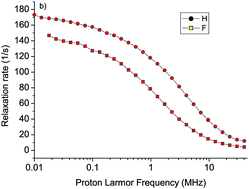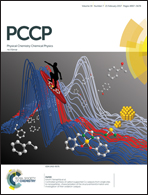Correlated/non-correlated ion dynamics of charge-neutral ion couples: the origin of ionicity in ionic liquids
Abstract
Proton/fluoride spin–lattice (T1) nuclear magnetic relaxation dispersion (NMRD) measurements of 1-butyl-3-methyl-1H-imidazolium hexafluorophosphate, [C4mim][PF6], have been carried out using high field spectrometers and a fast-field-cycling instrument at proton Larmor frequencies ranging from 10 kHz to 40 MHz, at different temperatures. The NMRD profiles are interpreted by means of a simple relaxation model based on the inter- and intra-ionic dipole–dipole relaxation mechanism. Using an atomic molecular-ion dynamic simulation at 323 K the relevant spin dipole–dipole (DD) correlation functions are calculated. The results indicate that the NMRD profiles can be rationalized using intra- and inter-ionic spin DD interactions, however, anions are mainly modulated by ionic reorientation because of temporary correlations with cations, where modulation by translational diffusion plays a minor role. Reorientational dynamics of charge-neutral ion couples (i.e. [C4mim]⋯[PF6]) and [C4mim]+ ions are in the nano-second (ns) time range whereas the reorientation of [PF6]− is characterized by a reorientational correlation time in the pico-second (ps) regime. Based on the NMRD profiles we conclude that the main relaxation mechanism for [PF6]− is due to fast internal reorientational motion, a partially averaged F–F intra- and F–H inter-ionic DD coupling as the anion resides in close proximity to its temporary oppositely charged cation partner. The F-T1-NMRD data display a ns dispersion which is interpreted as being due to correlated reorientational modulations resulting from the H-containing charge-neutral ion couple [C4mim]⋯[PF6]. The analysis of ionicity is based on the free anion fraction, f, and it increases with temperature with f → 1 at the highest temperatures investigated. The fraction is obtained from the H–F NMRD profiles as correlated–non-correlated dynamics of the ions. The analysis of T1 relaxation rates of C, H, F and P at high fields cannot generally give the fraction of ions but is consistent with the interpretation based on the NMRD profiles with relaxation contributions due to DD-intra and -inter, CSA-intra (and -inter for C), including spin rotation for P. The investigation has led to a description of the mechanics governing ion transport in the title ionic liquid via identification of transient correlated/non-correlated ion dynamics.



 Please wait while we load your content...
Please wait while we load your content...